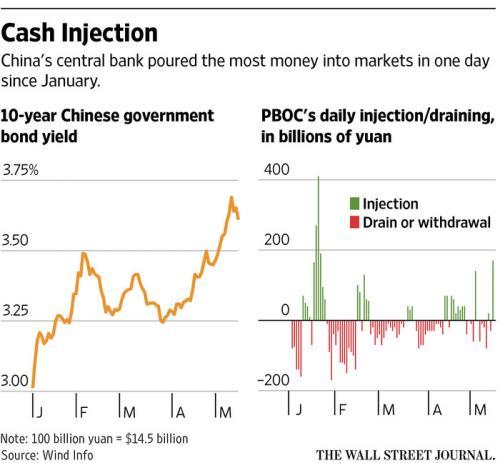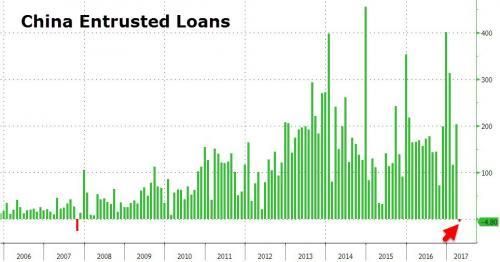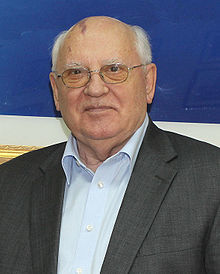Steve Bull's Blog, page 1366
May 17, 2017
“Look Ma, No Hands!”

“Look Ma, No Hands!”
The Deep State is escalating its war on President Trump but the Wall Street partiers apparently couldn’t care less. When the machines tagged 2402 on the S&P 500 yesterday, it was surely a historic case of “look ma, no hands!”
It’s hard to imagine what more will be needed to ignite an eruption of fear and panic in the casino amidst Wall Street’s record and wholly irrational state of somnolence.
After all, the Fed is sidelined and out of dry powder. The Red Ponzi is tottering. The U.S. retail sector is descending into an apocalypse. The giant auto bubble is fracturing. The Trump Stimulus is dead in the water, and Washington is heading for an extended stretch of complete dysfunction and acrimonious combat.
And if that isn’t that enough to upset the applecart — there are a lot more headwinds coming down the pike.
But the point is the insane governance process in Washington, which is completely unhinged, is combined with a level of insane complacency on Wall Street. Which is literally off the charts.
It would be one thing if our current fantastically inflated financial markets were reflective of a gusher of private sector growth, investment and productivity. That is, something like a new gilded age of invention and raw capitalist energy like occurred in the 1880s or 1920s.
The opposite is more likely the case, however. We have a mutant outbreak of financialization, debt, falsified financial prices and biblical levels of speculation and money shuffling — artificial economic conditions which are absolutely dependent upon agencies of the state.
Without treasury bailouts and endless central bank credit infusions, today’s massive financial bubbles would have splattered long ago.
…click on the above link to read the rest of the article…
The American dystopia didn’t begin with Trump
Media narrative includes myths fostered by Obama
 Hulu/courtesy Everett CollectionThe dystopian classic, “The Handmaid’s Tale,” is streaming on Hulu, sparking lots of false comparisons between the misogynistic dictatorship in the miniseries and the presidency of Donald Trump.
Hulu/courtesy Everett CollectionThe dystopian classic, “The Handmaid’s Tale,” is streaming on Hulu, sparking lots of false comparisons between the misogynistic dictatorship in the miniseries and the presidency of Donald Trump.WASHINGTON (MarketWatch) – Dystopia is here. It’s not just the “imagined place” of the dictionary definition or a future state of dystopian novels. It is very real and right now, at least for those of us trying to follow national politics.
And it’s not just Donald Trump. It’s Barack Obama, it’s Ted Cruz, it’s the New York Times, it’s Breitbart News. It is an alternate universe detached from the world we live in but intruding into it in painful and dangerous ways.
It is a media narrative of political conspirators colluding with a dictatorial archenemy, of an intemperate and delusional leader overturning the institutions of democracy, of a “deep-state” resistance to constitutional authority.
It is a dystopia of rampant hypocrisy, where obstructing legislation, supporting a law-enforcement official who strays beyond the limits of his authority, or boycotting a president’s appointments is evil and undemocratic until it’s your party that wants to do it.
Two dystopian classics have shot back to the top of best-seller lists because the media suggest the authoritarian surveillance societies they portray have arrived. The 1948 novel “1984” and the 1985 novel “The Handmaid’s Tale” are touted as descriptions of where we are headed under Trump.
While the author of “Handmaid,” Margaret Atwood, and the cast of the Hulu miniseries based on it see a Trump administration as the realization of the misogyny depicted in the novel, it’s obvious the U.S. is not about to become a Puritanical theocracy like that in the book.
Critics on both the left and the right dispute the media meme that “Handmaid” is a depiction of the Trump era.
…click on the above link to read the rest of the article…
May 16, 2017
The Federal Reserve Must Go
 If you want to permanently fix America’s economy, there really is no other choice. Even before Ron Paul’s rallying cry of “End The Fed” shook America during the peak of the Tea Party movement, I was a huge advocate of shutting down the Federal Reserve. Because no matter how hard we try to patch it up otherwise, the truth is that our debt-based financial system has been fundamentally flawed from the very beginning, and the Federal Reserve is the very heart of that system. The following is a free preview of an upcoming book that I am working on about how to turn this country is a more positive direction…
If you want to permanently fix America’s economy, there really is no other choice. Even before Ron Paul’s rallying cry of “End The Fed” shook America during the peak of the Tea Party movement, I was a huge advocate of shutting down the Federal Reserve. Because no matter how hard we try to patch it up otherwise, the truth is that our debt-based financial system has been fundamentally flawed from the very beginning, and the Federal Reserve is the very heart of that system. The following is a free preview of an upcoming book that I am working on about how to turn this country is a more positive direction…
*****
As the publisher of The Economic Collapse Blog, there have been times when I have been criticized for focusing too much on our economic problems and not enough on the solutions. But I believe that in order to be willing to accept the solutions that are necessary, people need to have a full understanding of the true severity of our problems. It isn’t by accident that we ended up 20 trillion dollars in debt. In 1913, a bill was rushed through Congress right before Christmas that was based on a plan that had been secretly developed by very powerful Wall Street bankers. G. Edward Griffin did an amazing job of documenting the development of this plan in his groundbreaking book “The Creature from Jekyll Island: A Second Look at the Federal Reserve”. At that time, most Americans had no idea what a central bank does or what one would mean for the U.S. economy. Sadly, even though more than a century has passed since that time, most Americans still do not understand the Federal Reserve.
…click on the above link to read the rest of the article…
China Capitulates: Injects $25 Billion Into Liquidity-Starved Banks To “Appease Investors”
Is China’s push to deleverage its financial system over?
That is the question following last night’s dramatic reversal in recent PBOC liquidity moves, when after weeks of mostly draining liquidity, the central bank injected a whopping 170 billion yuan (net of maturities), or $24.7 billion, the biggest one-day cash injection into the country’s financial markets (and contracting shadow banking system as first reported here last week, when we showed the first drop in China Entrusted Loans in a decade) in four months. The surprising move was “a fresh sign that Beijing is trying to mitigate the damage to investor confidence inflicted by its recent campaign to tamp down speculation fueled by excessive borrowing” according to the WSJ.
Today’s injection was the the largest since just before the Lunar New Year holiday in January, when Chinese banks traditionally stock up on liquidity.
Why the sudden shift?
On one hand it is possible that the PBOC is simple concerned about the sharp decline, and in fact contraction, in China’s shadow banking system, where as we showed last week Entrusted Loans posted their first decline since 2007 even as China’s M2 continued to decline.
The huge cash injection followed comments from Chinese officials in recent days which hinted they are getting concerned that recent moves to tighten market regulation have caused too much disruption. As a reminder, in recent weeks money market rates and yields on corporate bonds had all shot up to multi-year highs.
The real reason may be simpler: with a major leadership shuffle due later this year, the central bank is not taking even the smallest chances of turmoil in the banking sector. and as such admitted that – once again like in 2013 – its posturing to delever the world’s most leveraged financial system was just that. The WSJ has more:
…click on the above link to read the rest of the article…
State of Denial: The Economy No Longer Works As It Did in the Past
There’s no Plan B for a state-corporate form of central-planning capitalism that is no longer functioning.
If there is one reality that is denied or obscured by the Status Quo, it is that the economy no longer works as it did in the past. This is the fundamental economic context of our current slide into political-social disintegration.
The Status Quo narrative is: the policies that worked for the past 70 years are still working today. Boiled down to its Keynesian state-corporate essence, the Status Quo economic narrative is simple:
All we need to do to escape a “soft patch” (recession) is for governments to borrow and spend more money to temporarily boost incomes and demand until the private sector gets back on its feet and starts borrowing and spending more.
To help the private sector, central banks lower interest rates so it’s cheaper to borrow and spend.
As soon as the private-sector borrowing and spending rises, we can raise interest rates and trim state fiscal stimulus (i.e. governments borrowing and spending trillions more than they did before the recession).
But the inconvenient reality is these Keynesian policies no longer work. Fiscal stimulus (governments borrowing and spending trillions more than they did before the recession) has continued for a decade–or in Japan’s case, almost three decades.
The Keynesian gods have failed, but the worshippers of these false idols have no other form of black magic to turn to.
Why is fiscal stimulus now a permanent policy? The answer is uncomfortable: if fiscal stimulus is withdrawn (or even trimmed), the economy immediately goes into a self-reinforcing contraction.
As for near-zero interest rates: after 10 years of supposed “recovery,” central banks are terrified of pushing rates higher by quarter-point baby-steps, for the same reason that fiscal stimulus cannot be withdrawn: raising interest rates to historic norms would immediately send the economy into contraction.
…click on the above link to read the rest of the article…
Gorbachev Warns of Growing Danger
A group of Americans visiting Russia heard dire warnings from ex-Soviet President Gorbachev that the tensions between the U.S. and Russia are creating a dangerous situation for the world, reports Rick Sterling, who is on the trip.
The former President of the Soviet Union, Mikhail Gorbachev, is 87 years old but still sharp. He told a delegation of 30 Americans in a two-week visit to Russia organized by the Center for Citizen Initiatives, “This is a time to be concerned. We should worry about relations between our two countries. … Things cannot continue as they are.”
Former Soviet leader Mikhail Gorbachev
President Gorbachev recalled his initial meetings with President Reagan, which came after six years of poor relations and hostility. In the first summit meeting, Reagan issued a long list of accusations against the Soviet Union; Gorbachev responded with his own accusations against the U.S. After that meeting Gorbachev said “He’s not a hawk; he’s a dinosaur” while Reagan said about Gorbachev “He’s a die-hard communist.”
At the next summit meeting, Reagan continued lecturing Gorbachev. After listening for 15 minutes. Gorbachev stopped Reagan saying, “That’s enough. If you want to talk as equals we can go very far. Differences can be bridged. Problems can be resolved. But as equals.”
Reagan asked how the Soviet Union would respond if the United States was at risk because of some kind of natural calamity. When Gorbachev said his people would want to help, not take advantage, the mood changed.
Gorbachev recalled his own friendly experience talking with average Americans. He suggested that perhaps the U.S. needs its own perestroika. He reminded us that it was President John F Kennedy who said “We need peace but not a Pax Americana ….. not merely peace for Americans but peace for all men and women.”
…click on the above link to read the rest of the article…
NATO Builds Infrastructure for Permanent Military Presence Near Russia’s Borders

NATO Builds Infrastructure for Permanent Military Presence Near Russia’s Borders
A group of about 50 combat engineers based at Canadian Forces Base Gagetown were deployed to Latvia on April 29 as part of Operation Reassurance. The mission is to build a town for 500 soldiers. According to commanding officer Lt.-Col. Chris Cotton, the installation will have «everything you would expect in a small town, from its kitchen to its quarters, its electrical distribution system, water distribution system, internet, gym facilities that would allow people to survive over the long term in Latvia». Obviously, this is an element of vast infrastructure to provide for a long-term commitment.
In early April, a US-led battle group of 1,350 soldiers for NATO’s Enhanced Forward Presence in Eastern Europe arrived at its base near Orzysz in northeastern Poland. It took place just a few days after a NATO-Russia Council meeting took place on March 30. Secretary-General Jens Stoltenberg called the talks with Moscow «frank» and «constructive». Then the usual song and dance followed under the slogan of Russian threat.
British RAF fighters are scheduled to be stationed to Romania this May. In March the first of 800 UK troops arrived in Estonia supported by around 300 armed vehicles. Along with French and Danish forces they’ll be stationed there on what NATO leadership calls «rotational basis». In January, German and Belgian forces arrived in Lithuania near the Russian enclave of Kaliningrad.
The UK leads the Estonia Battlegroup while other NATO members are deploying forces to Latvia, Lithuania and Poland as part of the bloc’s Enhanced Forward Presence battalion. All in all, 4,000 NATO troops with tanks, armored vehicles, air support, and high-tech intelligence centers deployed to Poland, Latvia, Lithuania, and Estonia.
In accordance with the fiscal year 2017 European Reassurance Initiative budget proposal, the US Army is reopening or creating five equipment-storage sites in the Netherlands, Poland, Belgium and two locations in Germany.
…click on the above link to read the rest of the article…
‘The worst scenario’: What if Canada’s real estate bubble bursts?
A repeat of Toronto’s 1989 crash could have devastating effects on the entire economy

Builders work on a new home in North Vancouver in 2016. The average home price in Canada climbed by 10 per cent to $559,317 in April, the Canadian Real Estate Association says. (Canadian Press)
It’s the question lingering behind every headline. It’s whispered among homeowners, would-be buyers and sellers, economists and policy-makers. What actually happens if Canadian real estate prices crash?
On the one hand, a crash might be good for some Canadians already priced out of the market. And even a dramatic 40 per cent drop in prices would set homeowners in markets like Toronto or Vancouver back, what, two or three years?
But there are broader concerns for the market and the economy itself that could prove devastating.
Home prices are notoriously off the charts. Everyone from the governor of the Bank of Canada to the chatty guy in your local cafe has said, repeatedly, that this increase in prices is not sustainable. But what that means, precisely, is vague.
The latest numbers from the Canadian Real Estate Association show the average home price in Canada climbed by 10 per cent to $559,317 in April. Notably, the number of sales in Toronto’s red-hot market fell by almost seven per cent but prices continued to rise.
No one is saying the end is nigh. Most are still banking on that ambiguous “soft landing” policy-makers have talked about for years. But, for the sake of argument and for a better understanding of the risks, let’s talk about what a real crash would look like.

A ‘Sold’ sign is stands at an empty lot in a new subdivision in Calgary in 2015. Canadian home prices are off the charts, and a lot of people say they are not sustainable. But what that means is vague. (Reuters)
…click on the above link to read the rest of the article…
BOMBSHELL: Seth Rich Was In Contact With Wikileaks Says Former DC Homicide Detective
 It’s been close to a year since Seth Rich, the 27 year old computer expert who worked for the DNC, was murdered – shot twice in the back without anything of value taken from him. Rich was found alive and in shock before he bled out – his death ruled nothing more than a botched robbery.
It’s been close to a year since Seth Rich, the 27 year old computer expert who worked for the DNC, was murdered – shot twice in the back without anything of value taken from him. Rich was found alive and in shock before he bled out – his death ruled nothing more than a botched robbery.
Many suspect Rich was the source of the leaked DNC emails provided to WikiLeaks – a rumor which was fueled by the odd circumstances surrounding his death, the sudden retirement of D.C. Police Chief Cathy Lanier five weeks after the murder, and an email John Podesta sent to Hillary’s inner circle about making an example of a suspected leaker.
View image on Twitter

Follow
WikiLeaks ✔@wikileaks
Podesta: “I’m definitely for making an example of a suspected leaker whether or not we have any real basis for it.” https://www.wikileaks.org/podesta-emails/emailid/36082#efmAGSAH- …
7:46 PM – 30 Oct 2016
In the aftermath of the shooting, the Rich family hired a private investigator – Rich Wheeler, a former D.C. homicide detective who says evidence on Seth Rich’s laptop suggests that he was in contact with WikiLeaks prior to his death.
Furthermore, Wheeler believes there has been a cover-up
“The police department nor the FBI have been forthcoming,” said Wheeler. “They haven’t been cooperating at all. I believe that the answer to solving his death lies on that computer, which I believe is either at the police department or either at the FBI. I have been told both.”
When we asked Wheeler if his sources have told him there is information that links Rich to Wikileaks, he said, “Absolutely. Yeah. That’s confirmed.”
“I have a source inside the police department that has looked at me straight in the eye and said, ‘Rod, we were told to stand down on this case and I can’t share any information with you.’ –Fox5
…click on the above link to read the rest of the article…
May 13, 2017
Comey and the End of Conversation

Ray K. Metzker Philadelphia 1962You might have thought, and hoped, that recent events, such as the election of Trump as president of the US, or Brexit, or the rise of Marine Le Pen and other non-establishment forces in Europe, would, as a matter of -natural- course, have led to increased conversation and discussion between parties, entities, whose divisions were material in sparking these events.
But the opposite has happened, and continues to happen at an ever faster and fiercer pace. Various sides of various divides become ever more deaf to what other sides have to say. What still poses as conversation turns into blame games and shouting matches replete with innuendo, fake news and insinuations.
The mainstream media even find they are to an extent redeemed by this -at least financially-. Formerly last-gasp ‘news sources’, suffering from the advent of the interwebs, like the New York Times, CNN, HuffPo and WaPo, as well as Fox, Breitbart on the other side, and many others, have seen their reader- and viewerships expand over the past year as they turned into increasingly impenetrable echo chambers.
They may be losing a lot of potential attention -and revenues- from one side of the -former- debate, but that is more than made up for by rising attention from their faithful flocks. The public feel they need to have an opinion on political matters, and the media are more than willing to define, construct and phrase that opinion for them, to first confirm what people already think, and then raise it a notch or two, or three, or ten.
…click on the above link to read the rest of the article…






